
|
The Society of Folk Dance Historians (SFDH)
The Tatra Mountains
[
Home |
About |
Encyclopedia | CLICK AN IMAGE TO ENLARGE |
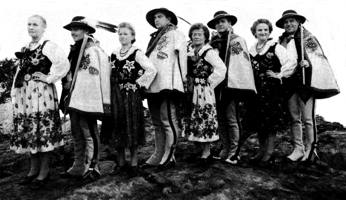
|
THE TATRAS' ALLURING BEAUTY
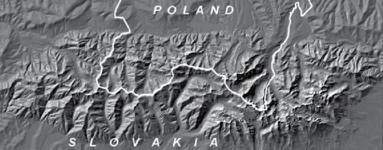 The Southern part of Poland, the Podhale ("Unterbergen" or Piedmont) region, is dominated by the majestic Tatras, those towering mountains to which nature itself seems to have assigned the role of master over the land's destiny. The Tatras hold sway over the emerald, gold, and brown checkered landscape at their foot, over the picturesque villages whose wooden cottages are embellished with artistic carvings.
The Southern part of Poland, the Podhale ("Unterbergen" or Piedmont) region, is dominated by the majestic Tatras, those towering mountains to which nature itself seems to have assigned the role of master over the land's destiny. The Tatras hold sway over the emerald, gold, and brown checkered landscape at their foot, over the picturesque villages whose wooden cottages are embellished with artistic carvings.
Their influence is felt by the mountain people whose love for the Tatras is deep and passionate and it is felt by the cattle and sheep peacefully grazing in the fragrant meadows. Their grim shadows fall upon the sunny valleys and clearings, upon the winding roads and paths, upon the purplish pine and beech forests, upon the precariously climbing dwarf pine and edelweiss. Their naked and glittering summits soar into the sky for over 3,000 feet above the roof of the forest, finally disappearing among the clouds.
In their beauty, the Tatras surpass even the magnificent Alps. As if aware of their magic charm, these grey and bluish granite skyscrapers, these jagged cliffs, these needle-like peaks projecting from the mass of lacy rock, view themselves with self admiration in the watery mirrors of the green mountain lakes.
Occasionally, a foamy cataract rushes down with a mighty roar, while shimmering brooks on every side murmur about the splendor of the Tatras. The mountains transform many of the streams into rivers, which flow down among the mountain people carrying in their wake prosperity or destruction, depending on the caprice of the Tatras' weather.
Disaster descends frequently upon these people, but the life-giving power of the sun in Podhale brings a welcome forgetfulness. Its rays warmly caress the rocks, the earth, the flowers, and the trees, revealing the breath-taking beauty of nature. In the winter time or in the early spring, when the Tatras are completely enveloped in the downy snow, the strong sun plays upon the frost, transforming its immaculate whiteness into a sparkling field of diamonds. The trees, with fluffy snow on their branches, assume a fairy-like appearance. This wondrous beauty of nature seems to be unreal, fantastic. But it is this haunting loveliness, blended with the stern reality of the sheer precipice, that accounts for the enduring appeal of the Tatras.
THE TATRAS' CAPRICIOUS CLIMATE
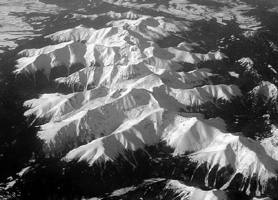 The gifts of the Tatra mountains to Podhale do not end with the beauty of the landscape and the crystalline purity of the air. One of the most curious natural phenomena existing in the Tatras is the extraordinary climate, which is capable of playing havoc with the seasons, transforming summer into winter or making winter out of summer. A Tatra summer in January or February is a unique experience, for the summer quality of the air is in marked contrast to the thick mantle of snow upon the ground and the trees. The frozen brooks and rivulets, the glistening icicles and the crackling frost betray the fact that this is still the Kingdom of Winter, momentarily invaded by the sun. The sun's rays bat with a fierce intensity against the snow. From time to time, the mountains, following a murmuring conference, seem to ally themselves with the sun in sending down a warm tornado. But even this union of forces avails little because the appearance of the moon heralds the news that winter once again has come into its own. This contest between night and day continues throughout the long months from January till the end of April, when the attacking strength of the sun becomes irresistible.
The gifts of the Tatra mountains to Podhale do not end with the beauty of the landscape and the crystalline purity of the air. One of the most curious natural phenomena existing in the Tatras is the extraordinary climate, which is capable of playing havoc with the seasons, transforming summer into winter or making winter out of summer. A Tatra summer in January or February is a unique experience, for the summer quality of the air is in marked contrast to the thick mantle of snow upon the ground and the trees. The frozen brooks and rivulets, the glistening icicles and the crackling frost betray the fact that this is still the Kingdom of Winter, momentarily invaded by the sun. The sun's rays bat with a fierce intensity against the snow. From time to time, the mountains, following a murmuring conference, seem to ally themselves with the sun in sending down a warm tornado. But even this union of forces avails little because the appearance of the moon heralds the news that winter once again has come into its own. This contest between night and day continues throughout the long months from January till the end of April, when the attacking strength of the sun becomes irresistible.
But during the warm weather, winter tries to avenge the sun's designs upon it. Cold days in June recur frequently and at times July, which is the wettest month in the year, abounding in devastating floods, even brings snow. The high humidity often provokes storms. These begin with a single thunder clap that reverberates from one Tatra wall to another and which, before it has time to die away, is followed up by a series of resounding peals, endlessly reiterated among the peaks and valleys. The mist is constantly pierced by the zigzag lightning, illuminating everything with a peculiarly pale and dazzling light. The accompanying rain pours in cascades, loosening boulders on its way and completely washing out the barren soil of Podhale.
The soil is barren. Tremendous labor is required in forcing it to yield a meagre grain crop and not infrequently the never slumbering Tatras send down a tornado to prevent even this pitiful harvest from being reaped. A Tatra tornado is indeed an awe-inspiring spectacle. Accompanied by a terrifying howling and deafening noise, it rushes through space, hurling aside everything in its path, uprooting age-old trees, tearing down roofs, dashing cottages to pieces. Bitter experience has taught the mountaineers, called "Górals," to anticipate nothing good from the muttering of their mountains. They are fully aware of the elemental forces imprisoned in the stony impassivity of the High Tatras.
MOUNTAINEERS' APPARANCE AND CHARACTER
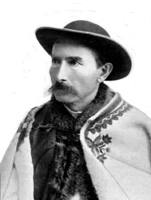 No people of any country are more influenced in their physical appearance and character by the land they inhabit than are the mountaineers of Podhale. Their hearts seem to be beating in harmonious unison with the rhythm of primitive nature. Their rocky homeland has made them a hard race. Some of the rugged beauty of the mountains is reflected in them – in their slender and lithe bodies, in their handsome, thin faces, alert, intelligent, full of energy and vigor, in their high cheekbones, aquiline noses, and shining eyes. The women of the Tatras are sometimes classic beauties.
No people of any country are more influenced in their physical appearance and character by the land they inhabit than are the mountaineers of Podhale. Their hearts seem to be beating in harmonious unison with the rhythm of primitive nature. Their rocky homeland has made them a hard race. Some of the rugged beauty of the mountains is reflected in them – in their slender and lithe bodies, in their handsome, thin faces, alert, intelligent, full of energy and vigor, in their high cheekbones, aquiline noses, and shining eyes. The women of the Tatras are sometimes classic beauties.
 Beaten from early childhood by the fierce rain, lashed by the mountain wind, and nourished by the meagre produce of their soil, every handful of which is a result of a bitter struggle, they have become tempered by hardship, persevering in overcoming adversity. In their inflexibility, in their enterprising spirit, in their thriftiness, they resemble the Scottish Highlanders, while their excellent shooting skill and extraordinary physical power reminds one of the heroic William Tell. Finally, one may detect something of the Native American in their art, in their great fondness for wandering among wild nature, in their gift of interpreting nature's phenomena, in the role in daily life governed by superstition, in their passion for hunting, in their love of music, dancing, and fire rituals.
Beaten from early childhood by the fierce rain, lashed by the mountain wind, and nourished by the meagre produce of their soil, every handful of which is a result of a bitter struggle, they have become tempered by hardship, persevering in overcoming adversity. In their inflexibility, in their enterprising spirit, in their thriftiness, they resemble the Scottish Highlanders, while their excellent shooting skill and extraordinary physical power reminds one of the heroic William Tell. Finally, one may detect something of the Native American in their art, in their great fondness for wandering among wild nature, in their gift of interpreting nature's phenomena, in the role in daily life governed by superstition, in their passion for hunting, in their love of music, dancing, and fire rituals.
They are not particularly fond of work. But when necessity compels them, they are capable of great effort and extreme sacrifices. Many of them crossed the Atlantic before the World War, undertaking the most menial labor in order to earn their living and eventually return to their homeland. But wherever they dwelled they were always lonely for their beloved Tatras. They were never happy without the sight of the Tatras or some mountains, rising in the distance. Away from their mountains, these mountaineers are the victims of an overpowering sadness and nostalgic longing. They are the only peasants in the world truly sensitive to the beauty of nature, capable of reacting in their own peculiar way to the various moods of the mountains.
Impulsive, quick to quarrel and to come to blows, nevertheless they possess a highly developed sense of humor and almost courtly manners. Very polite, but never humble towards visitors from the cities, they can, their pipes in their mouths, conduct a conversation with the lightness of a man of the world and with the facility of a diplomat.
Pride of family is a strong characteristic of the Polish mountaineer. The family tree is a topic of great importance, for descent from an ancient family ensures social prestige. No matter how shabby his dress may be, a member of the pioneer clan is proud of his ancestry, accepting no man as a master, and glorying in the freedom that has been since time immemorial.
MOUNTAINEERS' PICTURESQUE CEREMONIES
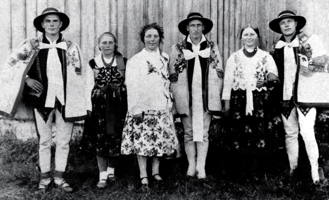 As everywhere among the Polish peasantry, many picturesque ceremonies are to be found in the Podhale region, accompanying all important events of life. to these belong, of course, the procedure of wooing and the wedding itself.
As everywhere among the Polish peasantry, many picturesque ceremonies are to be found in the Podhale region, accompanying all important events of life. to these belong, of course, the procedure of wooing and the wedding itself.
The wooer, accompanied by his attendants and with the obligatory flask of brandy, arrives at the cottage of his lady-love to ask her parents for their daughter's hand in marriage. The girl – so peasant decency and modesty requires – seems to be the last person to know anything of the real business of the long expected callers. She is seemingly busy around the house or yard. When the parents, after due ceremony, consent to give the daughter in marriage to the suitor, it is with the greatest difficulty that the girl is to be found – so deeply is she engaged in her work. Eventually, she hears the calls of her parents and comes running into the room, ablush, and attired in her Sunday's best. The apparently surprised maiden has been waiting all the time behind the barn or cow-shed, but age-old tradition demands that at this important moment she appear unconcerned about it all.
The wedding itself is a very picturesque affair. The mounted best men are followed by a cortege of beautifully decorated carts carrying the wedding guests. The manes and tails of the horses are entwined with flowers and multicolored ribbons and streamers. The greatest attention is commanded by the cart in which the bride rides wearing on her head a tall wreath-like decoration of flowers, beads, and streamers. On her white lace blouse glitters a beautifully embroidered bodice tightly laced at the waist and contrasting with the abundance of at least six skirts. Her neck is adorned with many strands of corals, usually preserved in the family from generation to generation. She cries all the way to the church and the bridesmaids, riding in the carts behind her, contribute further to the tearful atmosphere by singing melancholy songs about the end of girlhood.
After the church ceremony, the wedding party returns to the house of the bride's parents for the feast. The tables groan under copiously laden dishes and plates and the flask of brandy passes uninterruptedly from hand to hand. After the feast, the tables are placed under the walls and the dancing begins. Old and young dance as much as they can. The children from the whole village, attracted by the unusual sight, peep in excitedly upon the cheerful scene. Whoever has something on his mind or wishes to make some remarks fitting to the occasion, approaches the band, throws the fiddlers some coins, and improvises a song to the tune of the dance going on at the moment. About midnight, the married women drag the bride, who by now is almost hysterical with weeping and who makes strenuous efforts to defend herself, to the chamber where amid traditional and frivolous songs they tear from her head the floral wreath and replace it with a matron's bonnet. Thus attired, they lead her out of the chamber and hand her over to her waiting husband. Then follows the transportation of the dowry to the place where the couple will settle. Several wagons cannot contain all these chests, pillows, and featherbeds.
The entertainment continues through the night and not infrequently for another day or two. Sometimes, when some rejected suitors appear on the scene or perhaps a hot-blooded youth made eager for a fight by an excess of brandy, peace is disturbed by violent skirmishing not uncommonly accompanied by blood shed.
Specifically local in color is the ceremony of driving out the sheep to the mountain pastureland. Repeated every year after year from time immemorial, it developed permanent traditional forms connected with various superstitions, practices, and prayers.
The shepherds from the vicinity tending the sheep on the same pastureland, gather in one glad awaiting, with their chief shepherd (the "baca"), the animals arriving at the meeting place and driven there by the neighboring villagers. The dairymaids stand nearby with their cows. The barking of the shepherds' dogs mingles with the bleating of the sheep and lowing of the cows. The farmers with their wives and children gather around to say goodbye to the shepherds and shepherdesses and to take leave of their cattle. There is noise and commotion everywhere. Out of joy, that the time of going up into the mountains has come at last, the shepherds now and then let forth merry shouts, whistle, or, in the manner of a drum-major, throw their brass-studded axes, called "ciupagi," high into the air.
All await the sign of the "baca" to set out. Finally, the "baca" says: "It is time" and with a sprinkler dipped in holy water he sprinkles the sheep around him and prays for blessing and preservation from misfortune. Then he advances to the head of the procession, makes the sign of the cross with his "ciupaga" and lifts it with its glittering edge turned upwards. Whereupon, the shepherd-lads play on their flutes, on their fiddles, or on their bagpipes, jingling the metal rings on their "ciupagi." The others give vent to joyful shouting; the dairymaids urge on their cows, now and then singing a stanza of a merry song. The procession slowly moves off to the mountains amid the clatter of sheep's and cows' horns. Of the multitude of sounds and voices the most beautiful is the melody of the hundreds of brass bells on the necks of the sheep and cattle. The "baca" opens the procession with the dogs, them come the sheep watched on the sides by the shepherd-lads, the rear being closed by the cows and the cowherdresses and wagons laden with the necessary dairy and chalet equipment. The procession turns left and right following the winding road. The melancholy voice of the pipes and the melodious jingle of the bells become fainter and fainter.
MOUNTAINEERS' MUSIC AND DANCE
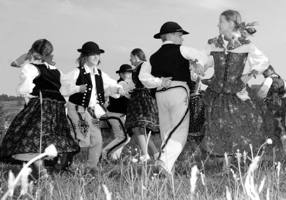 The same inborn artistic sense that impels the mountaineers to adorn the products of their hands in such a charming and unpretentious manner is also manifest in their music. The melodies of the Podhale and the dance music based on them are one of the most interesting manifestations in the whole of Podhale folk culture and in character, content, and form they are entirely different from the folklore of the rest of Poland.
The same inborn artistic sense that impels the mountaineers to adorn the products of their hands in such a charming and unpretentious manner is also manifest in their music. The melodies of the Podhale and the dance music based on them are one of the most interesting manifestations in the whole of Podhale folk culture and in character, content, and form they are entirely different from the folklore of the rest of Poland.
The songs of Podhale reflect everything by which the mountaineer is surrounded in his life; the immense, breath-taking beauty of the realm of the Tatra peaks, the steep rocky walls, the pastures and forests, the ancient glory and greatness of that land, the hard struggle for life, the agricultural occupations, and the ceremonies; they express the mountaineer's passions, his loves, his longings, and his sorrows.
These airs were born out of a sense of freedom. They were caressed by the breeze of the mountain pastures, obtaining their form from the rocky peaks. Devoid of sentimentalism, but characterized by an inflexible, hard sincerity, like that of the mountaineer's nature, they became the best expression of the mountaineer's soul.
The merry songs of Podhale, as well as those full of melancholy longing, have no stable "pattern." Each village sings them individually, giving vent to its innate fantasy.
The innate sense of humor is manifested in some songs dealing with the ways of love, as, for example, when the jolly girl confesses with sincerity:
"One abandoned me, but still I have nine,
Four in the mountain pastures,
Five on the Dunajec river."
or when the mountain lad jeers:
"Don't worry lassie. I shall have thee nevertheless,
When I only shall have cut the rye on the mountain."
The Podhale dance music rings with the joy of life and is a remedy for evil and sorrow. Its rough, sharp-edged form, as if hewn in solid rock, is a perfect work of art. Its fascinating power attracts many composers endowed with creative imagination. From among many names, that of Karol Szymanowski, the author of "Harnasie," stands out most distinctly.
The native musical band consists of two violins and a bass-viol. Sometimes, a bagpipe is added, but this instrument is rapidly disappearing.
The music, like the dancing, is wild, passionate, suited for dancers of vehement tempers. In the past, there were many of these dances; today, the Drobny (small-step) and Zbójnicki (robbers' dance) are still popular. The Drobny is a dance for men and women, symbolic of the struggle of the sexes; at first the woman approaches her partner in an alluring and enticing pose and then gracefully eludes him, running on her toes or knocking one heel against the other. The man wheels around her frantically, all atremble, singing to the tune or intoning a new air. The tempo becomes quicker and quicker. Both the players and the dancers are seized with frenzy. Their feet move with such rapidity that the eyes are unable to distinguish their individual movements. From time to time, they kick their heels backward, clapping then with their palms. Finally, the man seizes the woman and whirls her around. This is the signal for the next couple to begin their dance.
The Zbójnicki starts in a serious mood, the chief marching past a row of young men brandishing their axes, but quickly changes into a series of violent bendings with a simultaneous kicking out of the legs. The rapturous rhythm of the tapping of the moccasined feet is stunning. Everything resounds with the mountaineers' inexhaustible energy and vitality. The outbursts of the mountain gale are reiterated in those wild and violent dances bearing witness to the exuberance and picturesqueness of life in Podhale in days gone by.
DOCUMENTS
- Janja Jánošík, a hero.
- Poland, a country.
- Rod and Helen LaFarge, an article.
- Rosin the Bow, a magazine.
- Slovakia, a country.
Printed in Rosin the Bow, Volume 2, Number 12, December 1946.
This page © 2018 by Ron Houston.
Please do not copy any part of this page without including this copyright notice.
Please do not copy small portions out of context.
Please do not copy large portions without permission from Ron Houston.